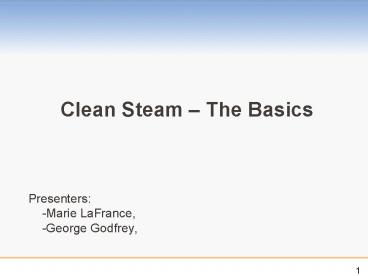Clean Steam - PowerPoint PPT Presentation
1 / 29
Title:
Clean Steam
Description:
Can use softened feed water to decrease water hardness Boiler water is chemically treated to control pH levels What does the Plant Steam System Look Like? – PowerPoint PPT presentation
Number of Views:271
Avg rating:3.0/5.0
Title: Clean Steam
1
Clean Steam The Basics
- Presenters
- -Marie LaFrance,
- -George Godfrey,
2
Clean Steam The Basics
- Objectives
- What is Currently Driving Clean Steam Initiatives
in Healthcare - How Water Quality Effects the Steam Generation
Process - Define the Different Types of Generated Steam
Available - Describe the advantages and disadvantages of
Clean Steam
3
Whats In it for Me?
- Provides you the basic Knowledge related to the
clean steam story - Prepares you for additional training at the
upcoming Sales Meeting in Tampa, Fl.
4
Healthcare and the Need for Clean Steam
- Traditionally used in Life Science and
Pharmaceutical application - Newer Technology to Healthcare, but not for Life
Sciences - Europe has adopted standards specific to clean
steam - EN 285
- HTM 2031
- International Standards
- ISO 17655
- Competitors has been an advocate for Clean Steam
in Healthcare sterilizers
5
Establishing Water Quality
- Waters basic structure is H20 But additional
elements may exist - Metals (K, Al, Cu, Na, Fe, Zn)
- pH Factors (Carbonate, Hydroxide, Bicarbonate)
- Hardness (Calcium and Magnesium)
- If not monitored or treated properly can have a
direct impact on the steam process
6
Establishing Water Quality
- Potable water quality is highly variable across
the country, even in locations that are in close
proximity - STERIS TSSR water analysis program can assist in
determining Customers water quality issues - As it relates to the water used in generating
steam, the Customer has options. - Those options are directly aligned with the type
of steam the hospital chooses to produce
7
Water Quality - Steam Generation
- Water used in steam production is known as Feed
Water - The type and quality of the feed water used is
determine by the type of steam the Customer
requires.
Water Softener System
Water Softener System
8
Softened Water
- Controls water hardness with earth alkaline
metals Ca, Mg, content in the feed water - Hardness in a water supply can result in scale
formation, which is a deposit of minerals left
after evaporation - The softener contains the treated ion exchange
resin - small beads of polystyrene - Exchange removes Ca and Mg from water
9
DI and RO Purified Water
- Deionized (DI) Water
- -Physical process using ion exchange resin
- -Traps specifically charged ions such as
- -Na, Ca, Fe, Cu, Cl, Chloride and Bromide
- Reverse Osmosis (RO) Water
- -Liquid Filtrations method
- -Water forced through membrane at high pressure
- -Pore size of membrane limits specific elements
from passing
DI System with Water Softener
10
Application to Healthcare Steam Sterilization
Types
- Softened water can be used in both plant steam
and clean steam applications - RO or DI water can be used in clean steam
applications, but piping and components must be
stainless steel due to the corrosive nature of
the treatment - Lets take a look at each of the steam methods
offered in greater detail
11
So what is steam?
12
Steam is just steamright??
13
Types of Steam
Pharmaceuticals and Biotechnology
Life Sciences, Hospitals, Food and Beverage
Hospitals / Food and Beverage
Hospitals, Laundries, Food and Beverage,
Pulp and Paper Petrochemicals
14
Plant Steam
- Most common grade of steam used in U.S.
healthcare - Sometimes referred to as House steam
- Can be used for multiple applications including
sterilization, laundry and heating. - Can use softened feed water to decrease water
hardness - Boiler water is chemically treated to control pH
levels
15
What does the Plant Steam System Look Like?
16
Typical Plant Steam System
Tee fitting
Incoming City Water
Pressure Regulator
Water Treatment System
Boiler
Chemical Boiler Treatment
Sterilizer
trap
trap
trap
17
Plant Steam
- Must be clean dry and free of boiler carryover
- Dirty or wet steam may effect plant steam
performance and increase maintenance costs - What are the effects of dirty steam?
18
Steam Quality
- Effects of Generating Poor quality steam
includes - Scale
- Rust
- Spotting/Staining
19
Poor Steam Quality - Scale
- Scale in Chamber
- Poor quality steam
- Boiler water carryover
- Inadequate boiler treatment
- If steam is from a steam generator then the
proper water quality is not being used
20
Poor Steam Quality - Scale
- Scale in Boilers
- Insufficient boiler treatment
- Scale buildup
21
Poor Steam Quality - ScaleDeposits/Corrosion in
Autoclave
22
Poor Steam Quality Rust
- Boiler Lines
- Carryover from steam
- Insufficient boiler treatment
- Poor quality steam
- Insufficient use of neutralizing amines
23
Wrapped Goods Spotting/Staining
- Laundry residues
- Boiler carryover
24
Why bother with steam issues?
- Spotting, staining and corrosion
- can interfere with sterilizer operation
- Competitors are pushing the use of clean steam
25
What Other Types of Steam are Available?
26
Clean Steam
- Can be generated from potable, softened, RO or DI
water - Free of boiler additives
- Most cases use a small steam generator dedicated
to boiler - All pipes and process components are
copper/brass? - If RO/DI feed water used plumbing must be
stainless due to corrosive properties of treatment
27
Clean Steam Advantages/Disadvantages
- Advantages
- Preservation of instruments, less staining and
pitting - Leaves fewer deposits on sterilizer walls
- Disadvantages
- High cost to produce
- Corrosive requires stainless piping for
sterilizer
28
Summary/Conclusion
29
FAQs































